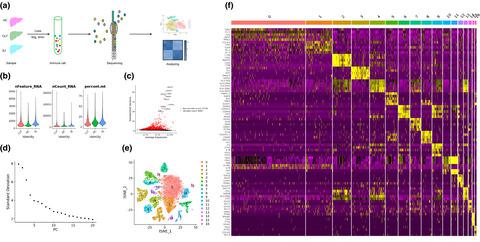当前位置:
X-MOL 学术
›
Immunol. Cell Biol.
›
论文详情
Our official English website, www.x-mol.net, welcomes your
feedback! (Note: you will need to create a separate account there.)
A preliminary investigation into the immune cell landscape of schistosome-associated liver fibrosis in humans
Immunology and Cell Biology ( IF 3.2 ) Pub Date : 2021-08-06 , DOI: 10.1111/imcb.12490 Yu Zhang 1 , Junhui Li 1 , Hao Li 1 , Zhaoqin Zhou 1 , Chen Guo 1 , Jie Jiang 1 , Yingzi Ming 1, 2
Immunology and Cell Biology ( IF 3.2 ) Pub Date : 2021-08-06 , DOI: 10.1111/imcb.12490 Yu Zhang 1 , Junhui Li 1 , Hao Li 1 , Zhaoqin Zhou 1 , Chen Guo 1 , Jie Jiang 1 , Yingzi Ming 1, 2
Affiliation

|
Schistosomiasis is a widespread helminth disease that poses a heavy social and economic burden on people worldwide. Advanced schistosomiasis often develops into schistosome-associated liver fibrosis, the pathogenesis of which remains unclear. This study aimed preliminarily to profile immune cells of schistosome-associated liver fibrosis using single-cell RNA sequencing. Three patient groups were enrolled, including an Schistosomiasis japonicum (SJ) group (n = 1), a chronic liver failure (CLF) group (n = 3) and a healthy control (HC) group (n = 2), revealing 17 cell clusters out of 20 093 cells. From these limited datasets, it was observed that T cell(1), mononuclear phagocytes-1 and dendritic cells (DCs) were higher in the SJ group. CAVIN2+ MP(2) was the predominant cell type in the MP subset of the SJ group (53%), and was higher than that in both the CLF (8%) and HC (1%) groups. Kupffer cell marker genes (CD163, MARCO and TIMD4) were enriched in caveolae-associated protein 2 (CAVIN2)+ MP(2), which was also an important source of TGFB1. The KEGG pathways of CAVIN2+ MP(2) indicated that they were associated with lysosome, endocytosis, phagosome and antigen processing and presentation. The preliminary study showed that granzyme B (GZMB)+ T cell(1) and ankyrin repeat domain-containing protein 36B+ T cell(3) were the most common T cells in the SJ group (50% and 32%, respectively). The KEGG pathways of GZMB+ T cell(1) were mainly related to natural killer cell-mediated cytotoxicity. The percentage of ring1 and YY1 binding protein (RYBP)+ DC(1) was higher in the SJ group (57%) than in the CLF (16%) and HC (6%) groups. The KEGG pathway of RYBP+ DC(1) was related to Fc gamma R-mediated phagocytosis and antigen processing and presentation. Overall, CAVIN2+ Kupffer cells were the main source of TGFB1, consisting primarily of mononuclear phagocytes in the livers of the SJ group subjects and potentially playing an irreplaceable role in hepatic fibrosis of schistosomiasis.
中文翻译:

人类血吸虫相关肝纤维化免疫细胞图谱的初步研究
血吸虫病是一种广泛存在的蠕虫病,给全世界人民带来了沉重的社会和经济负担。晚期血吸虫病常发展为血吸虫相关肝纤维化,其发病机制尚不清楚。本研究初步旨在使用单细胞 RNA 测序分析血吸虫相关肝纤维化的免疫细胞。纳入三个患者组,包括日本血吸虫病(SJ) 组 ( n = 1)、慢性肝功能衰竭 (CLF) 组 ( n = 3) 和健康对照组 ( n = 2),揭示了 20 093 个细胞中的 17 个细胞簇。从这些有限的数据集中,观察到 SJ 组的 T 细胞 (1)、单核吞噬细胞-1 和树突细胞 (DC) 较高。CAVIN2 + MP(2) 是 SJ 组 (53%) MP 子集中的主要细胞类型,高于 CLF (8%) 和 HC (1%) 组。库普弗细胞标记基因(CD163、MARCO和TIMD4)富含细胞膜穴样内陷相关蛋白 2(CAVIN2)+ MP(2),这也是TGFB1的重要来源。CAVIN2 +的 KEGG 通路MP(2) 表明它们与溶酶体、内吞作用、吞噬体和抗原加工和呈递有关。初步研究表明,颗粒酶 B ( GZMB ) + T 细胞 (1) 和含有锚蛋白重复结构域的蛋白 36B + T 细胞 (3) 是 SJ 组中最常见的 T 细胞(分别为 50% 和 32%)。GZMB + T 细胞(1)的KEGG 通路主要与自然杀伤细胞介导的细胞毒性有关。SJ 组 (57%)的 ring1 和 YY1 结合蛋白 ( RYBP ) + DC(1) 的百分比高于 CLF (16%) 和 HC (6%) 组。RYBP的KEGG通路+DC(1) 与 Fc γ R 介导的吞噬作用和抗原处理和呈递有关。总之,CAVIN2 +库普弗细胞是TGFB1的主要来源,主要由SJ组受试者肝脏中的单核吞噬细胞组成,可能在血吸虫病肝纤维化中发挥不可替代的作用。
更新日期:2021-09-02
中文翻译:

人类血吸虫相关肝纤维化免疫细胞图谱的初步研究
血吸虫病是一种广泛存在的蠕虫病,给全世界人民带来了沉重的社会和经济负担。晚期血吸虫病常发展为血吸虫相关肝纤维化,其发病机制尚不清楚。本研究初步旨在使用单细胞 RNA 测序分析血吸虫相关肝纤维化的免疫细胞。纳入三个患者组,包括日本血吸虫病(SJ) 组 ( n = 1)、慢性肝功能衰竭 (CLF) 组 ( n = 3) 和健康对照组 ( n = 2),揭示了 20 093 个细胞中的 17 个细胞簇。从这些有限的数据集中,观察到 SJ 组的 T 细胞 (1)、单核吞噬细胞-1 和树突细胞 (DC) 较高。CAVIN2 + MP(2) 是 SJ 组 (53%) MP 子集中的主要细胞类型,高于 CLF (8%) 和 HC (1%) 组。库普弗细胞标记基因(CD163、MARCO和TIMD4)富含细胞膜穴样内陷相关蛋白 2(CAVIN2)+ MP(2),这也是TGFB1的重要来源。CAVIN2 +的 KEGG 通路MP(2) 表明它们与溶酶体、内吞作用、吞噬体和抗原加工和呈递有关。初步研究表明,颗粒酶 B ( GZMB ) + T 细胞 (1) 和含有锚蛋白重复结构域的蛋白 36B + T 细胞 (3) 是 SJ 组中最常见的 T 细胞(分别为 50% 和 32%)。GZMB + T 细胞(1)的KEGG 通路主要与自然杀伤细胞介导的细胞毒性有关。SJ 组 (57%)的 ring1 和 YY1 结合蛋白 ( RYBP ) + DC(1) 的百分比高于 CLF (16%) 和 HC (6%) 组。RYBP的KEGG通路+DC(1) 与 Fc γ R 介导的吞噬作用和抗原处理和呈递有关。总之,CAVIN2 +库普弗细胞是TGFB1的主要来源,主要由SJ组受试者肝脏中的单核吞噬细胞组成,可能在血吸虫病肝纤维化中发挥不可替代的作用。










































 京公网安备 11010802027423号
京公网安备 11010802027423号